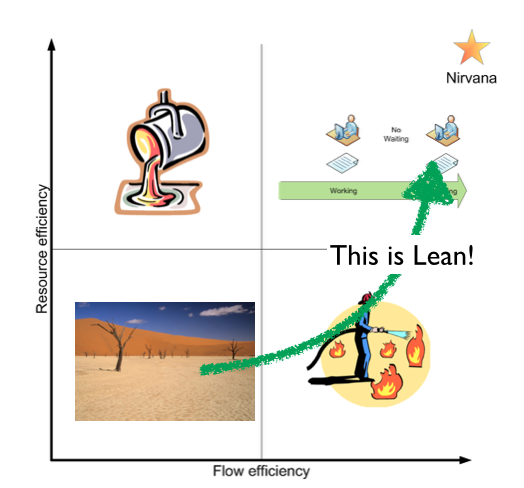Many daily stand-up meetings adhere to Scrum’s traditional format, where each team member reports on their activities from the previous day, plans for the current day, and any impediments they face.
While well-intentioned, this approach misdirects our attention.
Ensuring team members stay busy isn’t as crucial as ensuring work flows smoothly.
A simple adjustment can realign our focus, particularly during morning meetings.
- Blocked is not a column
- Todo - Doing - Done is not your process
- Done? There’s no Done
- Colors speaks volumes - use them deliberately
- It’s not a kanban board if you don’t have a WIP limit
- Walk the board from right to left
- Focus on the work - not the workers
- And for the love of everything holy - please tear off the post-it’s the correct way!
Introduction
I once lost a contract for affirming:
Are you the one telling teams that individual busyness isn’t important?
Yes, I did say that. And it’s true.
Most of us don’t ponder this much, but the three questions (™) overly emphasize individuals. Yet, our objective, like in many other practices, is to swiftly deploy small features to learn and adapt.
Why Address This Issue?
By prioritizing people over work (as LeanKit illustrates in their insightful article “Watch the Baton, Not the Runner”), we stray from lean principles.
Lean Philosophy
Lean, as depicted in This is Lean, balances resource efficiency (utilization) and flow efficiency (effectiveness). Although detailed elsewhere, I’ll share this insightful image by Per Åhlström and Niclas Modig:

The essence is achieving optimal flow by focusing on work, not individuals.
I find the emphasis on individuals distracts from critical discussions and improvements. For instance, the common post-three-questions inquiry:
Does everyone have work to do now?
However, as Niclas Modig argued at LeanKanban Central Europe, a 100% utilized team stifles innovation and customer focus.
Agile Manifesto
Beyond lean, prioritizing individuals over work contradicts two principles of the agile manifesto:
- Simplicity—maximizing work not done—is essential.
- Working software is the primary measure of progress.
Focusing on individual busyness neglects these principles, deviating from the core agile ethos.
What to Fix/Do Instead?
Let’s move beyond theory and take action.
Recognize the disparity between resource busyness and flow effectiveness. Then, adjust morning meetings to center on work, not individuals.
Simplify Morning Meetings
Instead of questioning each team member, focus on the work:
- Identify each task on the board.
- Discuss impediments hindering flow.
- Direct attention to tasks deviating from the flow.
This streamlined approach not only maintains focus but also accelerates meetings.
Tailoring for Large Teams
For larger teams, streamline meetings by:
Focusing on Anomalies
Prioritize discussions on anomalies rather than routine tasks:
- Unassigned work.
- Columns exceeding WIP limits.
- Blocked items.
- Resource monopolization.
Addressing anomalies catalyzes process improvements.
Problem-Solving Orientation
Direct meetings toward problem-solving:
- Identify obstacles.
- Delegate resolutions to involved parties.
- Avoid prolonged discussions in meetings.
Solve issues efficiently, keeping meetings productive.
Mitigating Managerial Overtones
To prevent meetings from feeling like reports to management:
Rotate the daily facilitator role.
This fosters inclusive thinking and eliminates hierarchical undertones.
Summary
In morning meetings, prioritize discussing work over individual updates. Focus on facilitating work flow by addressing impediments and anomalies on the board.
For more insights, explore related posts below.
- Blocked is not a column
- Todo - Doing - Done is not your process
- Done? There’s no Done
- Colors speaks volumes - use them deliberately
- It’s not a kanban board if you don’t have a WIP limit
- Walk the board from right to left
- Focus on the work - not the workers
- And for the love of everything holy - please tear off the post-it’s the correct way!